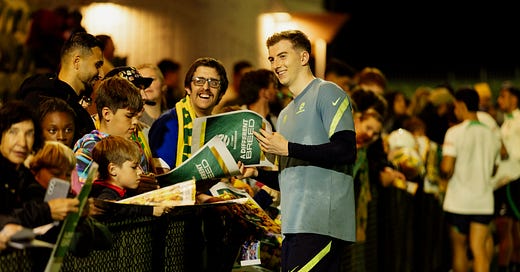Australian football saw a 178% increase in transfer fees paid for men’s players during the 2023-24 fiscal year according to a new report from Football Australia, with A-League Men sides bringing approximately AUD 17.4m in fees.
Examining moves completed between July 1 2023, and June 30 2024, FA said 400 male players had secured overseas moves across the reporting period, up 125% on the 177 that did so in 2022-23. 20 of this cohort, drawn from six clubs, moved for a transfer fee, up just one from the 19 the previous year but bringing in a significantly higher collective sum.
In the women’s game, free transfers remained the preeminent form of transfer for the 97 from A-League Women and NPLW sides that moved overseas, up 46% on the previous year. Three A-League Women players, up from one in 2022-23, moved for fees: Sarah Hunter moving to Paris FC and Melbourne City setting new Australian records after dealing Lysianne Proulx to Bay FC and Kaitlyn Torpey to the San Diego Wave in the NWSL.
"The A-Leagues is proud of the tremendous growth of transfer fees generated across the A-League Women and A-League Men, which highlights the quality and the increased appeal for the footballers across our leagues,” said A-Leagues commissioner Nick Garcia.
“We will continue to work with the Australian football pyramid through domestic transfers to ensure as many young players are getting as many A-Leagues match minutes as possible to set them up for that journey and ensure the A-Leagues continues to be the place to watch the domestic stars of today and the global stars of tomorrow.”
Five transfers, per FA, made up approximately 50% of fees in the men’s game: Joe Gauci’s record move from Adelaide to Premier League side Aston Villa, Marco Tilio’s then-record sale from Melbourne City to Celtic, Nectarios Triantis’ shift to Sunderland from the Central Coast Mariners, Aziz Behich’s loan deal from City to Saudi powers Al Nassr, and Craig Goodwin’s transfer from Adelaide to Saudi side Al Wehdah.
Though the federation said that experienced players such as Goodwin and Behich attracted higher average fees, the $12.9m paid for players aged 18 to 23 during the reporting period represented a 218% jump on the $4.05m brought in during 2022-23 and represented 74% of total fees brought in.
In March, Garcia told ESPN that part of the league’s shift to a ‘Football Focus’ model was embracing its status as a development league, saying “Giving match minutes at a very young age is very important. Creating exciting, attacking football is important. Seeing young stars get developed is important.”
The Mariners led the Australian top-flight in player sales for the second-straight season by transferring seven players and, highlighted by the Gauci deal, Adelaide was the next most prolific with five. City, Macarthur, and Western Sydney also completed multiple transfers by making two each, while Melbourne Victory and the Newcastle Jets made one.
Approximately 87% of the fees paid to A-League clubs detailed by FA were of a fixed nature, compared to 13% that were the result of conditional payments. Like in the women’s game, however, the vast majority of deals remained free transfers – making up 70% of all moves. A-League clubs, in addition, paid $488,000 in training compensation — the majority distributed to clubs in NPL NSW and NPL Victoria.
Recent transfers such as Nestory Irankunda’s record-setting sale to Bayern Munich, Alex Paulsen’s sale to Bournemouth, and Jake Girdwood-Reich’s move to MLS side St. Louis City were officially completed outside the report’s date range and will be included in next year’s figures.
“The 2023/24 year was a game-changer for football in Australia,” said FA chief executive James Johnson. “The surge in transfers for both women’s and men’s football showcases the incredible talent coming through and the success of our reforms in creating a system that competes on the global stage.
“Women’s football continues to shine, with record-breaking transfer fees reflecting the high demand for Australian players worldwide. By building a transfer system that’s transparent, sustainable, and full of opportunities, we’re paving the way for a brighter future for our players, clubs, and fans.”
Football Australia’s figures come weeks after players' union Professional Footballers Australia released a report saying men’s transfer fees had exceeded the money brought in by the league's broadcast deal for the first time last season, alongside modelling suggesting the sale of players was a sustainable source of revenue for cash-strapped clubs that have been hit hard by a league-wide downturn in revenues.
The implementation of a domestic transfer system has long been a key goal of Johnson, with the federation previously adjusting the cap on fees for players transferring domestically and adjusting loan regulations — making it possible for member federation clubs to negotiate fees for contracted players moving to the A-League or other member federation clubs.
However, the long-standing ban on the payment of transfer fees between A-League sides remains in place; the PFA, in particular, is resistant to the introduction of these fees as long as the salary cap remains.
In August, it was announced that the FA would join league administrator the APL and the PFA on the A-Leagues’ professional football committees to review the role of the salary cap and explore the introduction of fees between clubs as part of the gradual phasing out of the 'Caceres Clause' that barred loans between multi-club groups.
Heaader Image: Football Australia





The elephant in the room is the NPL clubs are at least 4 years in arrears receiving training compensation. FA are shameless in providing the numbers owed, no mentioned of $ paid....